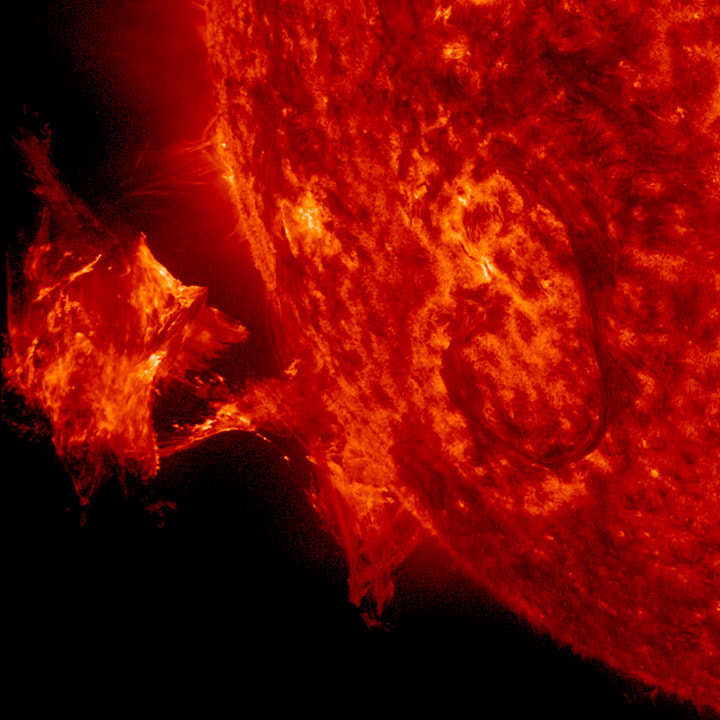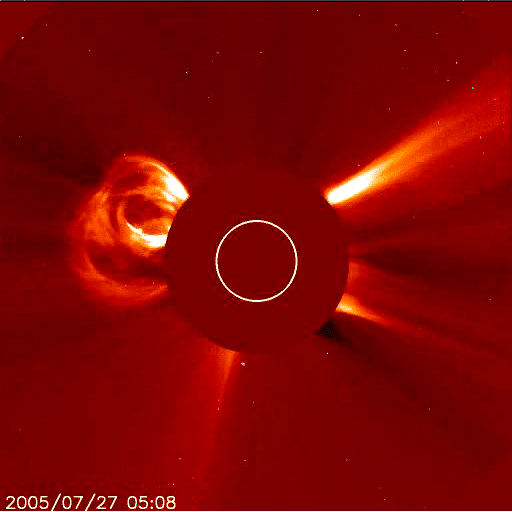Last month we looked at the spectacular prominences, and noted although massive compared to Earth, they pose only a limited hazard to either space equipment or the Earth. The much larger Coronal Mass Ejections (CMEs) and the very high energy flares however do not have the same benign features; and they can pose a real threat.
Le mois dernier nous avons considéré les protrubérances spectaculaires et nous avons remarqué qu’elles ne posent pas une grande menace à la Terre ou à l’infrastructure spatiale. Toutefois les éjections de masse coronale (qui sont plus grandes) et les éruptions solaires sont plus dangéreuses.
CMEs are massive, ‘explosive’, high energy events. They have been the topic of active research and study since their first confirmed detection in December 1971 by NASA’s Orbiting Solar Observatory (OSO-7). They can, and do, have a significant effect on space-weather and Earth’s magnetosphere.
CMEs are generally observed using coronagraphs and the larger (‘halo’ CMEs) are always observed by this means. The use of specialised solar satellites has enabled detailed study of both their nature and sources. For example, the Large Angle and Spectrometric Coronagraph (LASCO) instrument on board the SOHO (Solar and Heliospheric Observatory) satellite has provided extensive observations of these phenomena since its launch in December 1995.
CMEs are ejections of plasma in a bulbous form, and they occur throughout the solar cycle. Their frequency matches closely the solar cycle and varies from ~0.2 (at solar min) to 4.5 (at solar max) per day. Expulsion velocities and thermal energies also vary in line with cycle with CMEs at solar maximum approximately twice as energetic than those at are seen solar minimum. For example, ‘average’ eruption velocities are 550 and 250 km/s respectively.
Image taken at 304Å (an emission line of helium within the Extreme Ultra Violet (EUV) part of the spectrum) by the Atmospheric Imaging Assembly (AIA) instrument on the Solar Dynamics Observatory.
(Courtesy of NASA/SDO)
(Courtesy of NASA/Trace mission)
Whilst four billion tons of plasma may appear, and is to us mere humans, rather a large amount of matter, in context it is insignificant. It is about half of one-billionth of the mass of the Earth’s moon. When comparing this to the Sun’s mass loss due to the solar wind and due to energy production by fusion, we can see that CMEs are rather more important to humankind and Earth than to the Sun.
The high kinetic energies within CMEs are matched by their high thermal energies. They have typical temperatures of the order of a few million Kelvin.
There appear to be three principal sources for CMEs: eruptive (spray) prominences; flares with associate mass ejection; and the evolution of long-term filaments (disparition brusque). Less than half of all flares give rise to mass ejections. The ones that do are the cooler flares and produce less intense radiation. Disparition brusque is the name given to the rapid (a few hours) evolution of a hitherto relatively stable quiescent filament. The internal velocities of the filament begin to rise, and the filament rapidly ascends, increasing velocities as it does until an expulsion (the CME) occurs (when the velocities exceed the photospheric altitudinal escape velocity).
The root cause of CMEs, especially their very high energies, temperatures and velocities, continues to be an area of active research. The gradual build-up of instabilities within the magnetic field of the corona, caused by sporadic and systematic changes within the magnetic field of both the photosphere and convection layer, is currently thought to be significant but to date no comprehensive model is available or agreed amongst solar physicists.
The Sun is currently at the solar cycle minimum and has been unusually quiescent over the past few months. However, the solar activity will develop over the next few months and year so keep an eye out for our bulletins where we promote and distribute the SIDC alerts!
As usual, we can recommend our book on the Sun for those readers who would find out more about CMEs and indeed each of the topics covered within this blog series.
Finally, we would like to wish our all our readers a very happy and peaceful new year.
Actuellement le Soleil connaît une activité minimale, mais l’activité solaire recommencera dans les prochains mois. Regardez donc nos bulletins de nouvelles où nous publions des alertes du SIDC.
Comme d’habitude nous recommendons notre livre sur le Soleil pour ceux qui voudraient savoir plus sur les EMCs et les autres sujets couverts par ce blog.
Enfin nous souhaitons à tous nos lectures une très bonne année!



